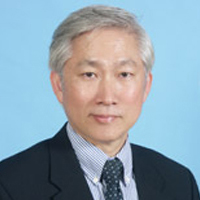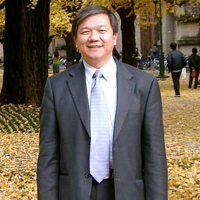| |
 |
|
|
 |
| |
 |
|
|
::: Congratulations to Professor Lee Chih-Kung and Professor Wu Tsung-Tsong, Professors of Applied Mechanics, who were both named 2006 ASME FELLOWS
Professor Wu Tsung-Tsong and Professor Lee
Chih-Kung were simultaneously named 2006 ASME Fellows (American Society of Mechanical Engineers.
ASME Fellow). Professor Wu was awarded the fellowship based on his outstanding contribution
to the research topic "ultrasonic research and nondestructive evaluation (NDE) of materials."
By integrating his experience working at IBM's Almaden Research Center in San Jose, California, Professor Lee was able to conduct many important interdisciplinary researches at the National Taiwan University's Institute of Applied Mechanics and win the ASME Fellowship. Over the past 12 years, Professor Lee integrated the fields of optics, electronics, biotechnology, piezoelectrics, MEMS and nano-technology into the field of mechanics, completing a number of important interdisciplinary research.
In the annual selection process, the ASME selects no more than 0.1% of its entire membership each time in an extremely rigorous selection process. ASME has more than 100,000 members in the world.
Professor Wu completed his studies in the United States and returned in 1987. Ever since, he has engaged in fundamental and applied research into the fields of elastic wave dynamics and ultrasonic non-destructive evaluation. Since the early days of his research, Professor Wu has combined elastic wave theory and acoustic backcalculation methods to widen the field of non-destructive testing technologies. Professor Wu is also committed to research studying the use of Laser Ultrasonics to test anisotropic material properties of composite materials. At the same time, the development of strong low-frequency ultrasonic sensor and actuator, piezoelectric sensor elements, and on-site measurement systems substantially improves upon the international standard testing equipment and technology. This technology has been successfully used in quality and safety inspections of Taiwan's nuclear power plants, skyscrapers, bridges, and other concrete structures.
|

Wu Tsung-Tsong, Professor of the Institute of Applied Mechanics of the College of Engineering, was named 2006 ASME Fellow for his outstanding contribution to the research topic "ultrasonic research and nondestructive evaluation (NDE) of materials.

Lee Chih-Kung, a joint professor with the Department of Engineering Science and the Department of Ocean Engineering, was selected as a 2006 Fellow for the American Society of Mechanical Engineers for his distinguished research achievement. |
|
Since 1980, Taiwan has gradually followed the footsteps of the United States and Japan to become one of the world's bases for quartz crystal oscillator industries. However this growth did not accompany a solid understanding of crystal vibration theory and analysis. In 1994, Professor Wu first established Surface Acoustic Wave Study and related advanced core technologies while successfully applying a self-developed SAW different frequency dispersion analysis to the piezoelectric layer diamond surface acoustic wave filter design. This distinguished Professor Wu's lab as the only laboratory in Asia, except Sumimoto Electronics in Japan, with this capability it auspices laboratory in Asia. A joint R&D venture with industry partners in 2000 resulted in the quartz crystal oscillator industry stepping into the high end world of SAW filter production. In addition to the acoustic filter Study, Professor Wu's surface acoustic wave components exhibit both academic and practical values when extended to biomedical inspections and control of micro-fluid applications.
Similar to the phenomenon of band gap exhibited by photonic crystals, cyclical elastic materials can also form phononic crystals and produce a band-gap for elastic vibrations (including acoustic bibrations). This band gap prevents the phonon transmission for specific incident angles and frequencies, forming a transformation effect for filter waves and elastic waves (P-wave. S-wave and SAW). Professor Wu began studying phononic crystals in 2000, establishing the theory to analyze SAW within highly anisotropic or piezoelectric phonoic crystals. Furthermore, he was the first to combine micrometer level phononic crystal production and layered RF surface acoustic wave components to successfully measure and confirm the existence of micrometer level crystal surface acoustic wave band gap. This is a key result in the development of phononic crystals in LSI technology for micro-acoustic channel and broadband filters.
Lee Chih-Kung, a joint professor with the Department of Engineering Science and the Department of Ocean Engineering, was also selected as a 2006 Fellow for the American Society of Mechanical Engineers. His research results include new piezoelectric sensor elements, piezoelectric transformers, surface plasma resonance and sub-wavelength nano-structure interaction with the laser, a lipid that could dissolve or render harmless such deadly viruses such as SARS or avian flu virus, blood analysis equipment based on Electrochemical theory, etc. Any one of these research areas can break some bottlenecks in global fundamental research. For example, by developing a new piezoelectric transformer power supply system from the systems integration perspective, Professor Lee has completed the development multiple new techniques capable of breaking through patent barriers in several countries, including a single piezoelectric transformer system integration technique. This technology has the potential to significantly improve the competitiveness of Taiwan's computer screen light source. Because of these research and development results, Professor Lee and his research team have won several domestic and international awards.
Generally speaking, Lee Chih-Kung, a professor and his team use "only do things useful to Taiwan, only do things of academic value "as a motto and created a new model of cooperation with industry partners. The research results also confirmed that only a multi-disciplinary applied science research team can create fundamentally innovative research results.
|
Copyright 2007 NTU Secretariat
|
|
Copyright © 2006 National Taiwan University
No. 1, Sec. 4, Roosevelt Road, Taipei, 10617 Taiwan(R.O.C.)
Phone: +886-2-3366-3366 Fax: +886-2-2362-7651
|

